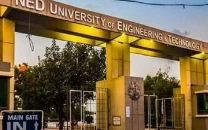Wars in the Age of AI
Later lethality kept improving as weapons and platforms kept gaining greater fidelity of targeting,

Exactly forty years back I was attached with the US Air Force briefly to work on a technology that the PAF was seeking to acquire for its newly inducted F-16s. In the world of military aviation and especially in South Asia it was to be a revolutionary addition. The US and Israeli air forces carried a variation but for the rest it was a new-new. That is when General Dynamics (now Lockheed) began advertising its one bomb-one target campaign for the F-16. Its accuracy was lethal. As part of the team test-flying the capability numerous additions and improvements were made turning it into a hands-off automatic targeting system that could take the load off a pilot's mind who could now turn his attention to other things. This and other such exotic additions to a warfighter's capability brought about what was termed Revolution in Military Affairs (RMA).
Later lethality kept improving as weapons and platforms kept gaining greater fidelity of targeting, tracking and engaging targets, both in the air and on the ground. A similar capability related to long-distance bombing was enabled by weapons which would glide a long distance while being controlled mid-flight till they reached their terminal stages to begin active tracking in autonomous mode. Till the early 1980s most advanced air forces of the world were limited to using the short-to-mid range anti-radiation missiles against targets emitting electromagnetic radiation - short for radars. The Israeli air force had used those to very great effect in 1982 in their brief skirmish with Syria in the Bekaa Valley. The evolution and the induction of something as revolutionary as the F-16 had excited imagination of minds and doctrines galloped with newer thoughts and employment options. What followed truly breached thresholds ushering a revolution in the art of war.
This is how things worked in an F-16 cockpit: A typical mission entailed attacking targets on the ground while fighting through a gaggle of enemy fighters and ground defences. The cockpit blurted out warnings, indications, targeting solutions and employment options, all at once. The pilot had two emergent tasks at hand, de-clutter the decision-process - prioritise - and activate the relevant response. It could be an emergent flying manouvre under imminent threat, or activation of a jamming option to disrupt an enemy's targeting solution, initiating self-defence passive measures, and pursuing the objective of either bombing a target or eliminating an adversary in the air. Mostly these were simultaneous actions but getting the sequence and the timing right was the key. Alongside was the need to keep a mental note of who was where, friends and the enemy - situation awareness - while still commanding, controlling and executing the employment of the formation of aircraft in pursuit of its objective. Time available to each was critical and precious. Predictability could kill.
A lot of the information to the pilot came through his on-board sensors or what he heard from his formation members and other supporting aircraft accompanying him for their respective roles. Many years after, pilot's workload has been made easier by a self-contained AI which per the pre-fed algorithms disaggregates the composite threat, prioritises and allocates in order of preference to the pilot what he must take on. The formation commander allocates other targets to other members from the composite picture he now sees on his screens even as he engages what is of vital imminence to him. Instant communication and exchange of data within the formation of fighters and support aircraft and with other controlling elements in the air now produce a composite air picture if needed on every screen in every cockpit. The pilots allocate their primary and secondary areas of search and targeting and share information from one another by data exchange. On-board computers already link aircraft systems, weapons, sensors and solutions for autonomous activation, reducing the workload of the pilot enabling him time to now dedicate to most optimal utilisation of the full destructive capability carried in the package. Early models of Quantum computing at speed of light extrapolate fighter's own parameters, enemy's data, and display instant solutions. What used to be cables and pulleys are now digital transducers, transmitters and receivers connected through dedicated links in every aircraft. The AI copilot has been active for some decades now.
Just as in modern life the 'Internet of Things' (IOT) and 'System of Systems' become integral components of a palm-held and controlled lifestyle management system, a fighter-pilot has literally lived these tools for the last forty years and more. 'Systems Integration' was the buzzword. Having been a part of the labs creating and activating these processes of modern technology was indeed a privilege less appreciated then. As computing speeds accelerate and more is done by chips in the heart of these computers, the fighters will become super-fast, super-accurate, super-lethal and super-capable. A fighter will always remain relevant because of the man-in-the-loop equation where Situation Awareness (SA) will be the biggest X-Factor in any dynamic situation of employment in combat. UAVs are a single-task machine capable of doing what is aimed in the most efficient manner unless it gets blown away before reaching the target. Employment options will entail a mix of all types of capabilities woven together through instant communication and computation.
The role of AI for a warfighter will now grow beyond the tactical to the operational and strategic. The prerequisite is to train the machine in mimicking a human response. Decision-making at the highest level of war is based less on set-piece situations than on the evolving nature of war. If one machine learned only one commander's mind over a long duration of exposure to his decision-making preferences it may be able to replicate it. But where situations change every moment as do commanders and their respective minds - and the art of war in application and employment may vary appreciably in degree of defensive or the offensive - it makes it almost impossible for a machine to copy and learn enough to act and autonomously decide the right course of action in those situations. Simulations could help machines learn but never to the extent where what they offer has the same credibility as the wisdom and art of decision-making by a warfighter at that level of command.
Command and control of nuclear weapons will be the Achille's heel as men and machines merge in most activities in life including warfighting. In no case, these, to any degree, must be left to the whims of a machine howsoever smart and trained those become in time. It would be just too dangerous to trust them with their responsibility. AI can assist in different ways with separately designed modules for nuclear command and control but the decision to finally push the button should always be a manual motion. Cybersecurity of another scale will gain eminence as man automates war.














COMMENTS
Comments are moderated and generally will be posted if they are on-topic and not abusive.
For more information, please see our Comments FAQ